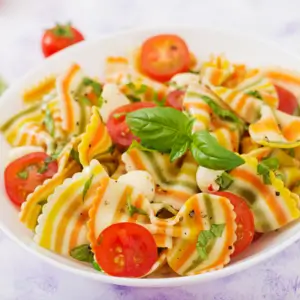Pasta salad is a versatile dish enjoyed by many across various cuisines, from Italian to American. It is a staple at barbecues, picnics, and potlucks due to its refreshing flavors and ease of preparation. In this comprehensive guide, we’ll explore everything you need to know about pasta salad, including ingredients, instructions, tips, and common mistakes to avoid. Plus, we’ll answer some burning questions about whether eating pasta salad is healthy and which types of pasta are best for this dish. Let’s dive in!
Table of Contents
ToggleSummary
Tips and Notes
- Make ahead: Pasta salad can be prepared a day in advance, but avoid adding the dressing until you’re ready to serve to prevent sogginess.
- Customize: Feel free to add ingredients like grilled chicken, shrimp, or roasted vegetables for a heartier meal.
5 Mistakes to Avoid
- Overcooking the Pasta: If it’s too soft, it will absorb too much dressing and become mushy. Always undercook slightly, especially if you’re serving it later.
- Skipping the Cooling Process: It’s essential to cool the pasta quickly after boiling by rinsing it under cold water. This halts the cooking process and prevents the pasta from becoming too soft.
- Using the Wrong Pasta: Avoid using thin pasta like spaghetti or linguine, which doesn’t hold up well in cold salads. Stick to short, sturdy varieties like fusilli, farfalle, or penne.
- Adding the Dressing Too Early: Add the dressing just before serving. Otherwise, the pasta will absorb too much and make the dish soggy.
- Not Seasoning Enough: Pasta salad needs a generous amount of seasoning, including salt, pepper, and herbs. Under-seasoning is a common mistake, leaving the dish bland.
What is Pasta Salad Made Of?
Pasta salad is a cold dish that consists primarily of cooked pasta combined with a variety of ingredients such as vegetables, proteins (like chicken or cheese), and a dressing (usually vinaigrette or mayonnaise-based). The ingredients vary depending on the recipe, but popular choices include:
- Pasta (Fusilli, Farfalle, or Penne work best)
- Vegetables (bell peppers, cucumbers, cherry tomatoes, red onions, etc.)
- Cheese (feta, mozzarella, or parmesan)
- Protein (chicken, tuna, or boiled eggs)
- Dressing (vinaigrette, ranch, or mayonnaise)
Pasta salad is a side dish that fits into multiple cuisines, including American, Italian, and even Mediterranean varieties.
Additional Ingredients to Enhance Your Pasta Salad
Beyond the standard vegetables, cheese, and dressing, pasta salad can be customized with various flavorful additions:
Best Practices for Storage
Proper storage ensures that your pasta salad maintains its flavor and texture:
Creative Variations of Pasta Salad
If you’re looking to experiment with different pasta salad varieties, here are some exciting alternatives:
Health Benefits of Pasta Salad
Pasta salad can be healthy or indulgent depending on how it’s prepared. Here’s how it can be a beneficial part of your diet:
For more about the health benefits of different types of pasta, you can visit: Pasta Nutrition.
Other Types of Pasta to Avoid for Salads
Avoid delicate pasta types like angel hair, spaghetti, or fettuccine for cold pasta salads. These varieties can become sticky and clump together when cold, making the salad difficult to toss and serve. Instead, use pasta that has ridges or grooves, such as fusilli or rigatoni, which hold dressing and other ingredients better. Additionally, gluten-free pasta can sometimes be too brittle for cold salads unless cooked very carefully.
For more about pasta varieties, refer to: Types of Pasta.
Advanced Cooking Techniques for Pasta Salad
1. Infusing Flavor Into the Pasta
- Boil in Broth: Instead of boiling your pasta in plain water, consider using chicken or vegetable broth. This adds a subtle flavor to the pasta itself, enhancing the overall taste of the salad.
- Add Aromatics to the Water: Throw in garlic cloves, bay leaves, or even a sprig of thyme into the water while boiling the pasta. This gentle infusion gives the pasta an extra layer of flavor.
2. Oil Coating Method
After draining the pasta, toss it lightly with a bit of olive oil to prevent clumping. However, be cautious with the amount. Too much oil will create a barrier and prevent the dressing from adhering well to the pasta. Aim for a light coat to keep the pasta from sticking while still allowing it to absorb the dressing.
3. Blanching Vegetables
If you’re using hardy vegetables like broccoli, carrots, or green beans, consider blanching them first. Blanching will soften the veggies slightly while maintaining their vibrant color and crunch. To blanch:
- Boil the vegetables in salted water for 2-3 minutes.
- Immediately transfer them to an ice bath to stop the cooking process.
4. Marinating Ingredients Separately
Marinate your vegetables (especially tomatoes or cucumbers) in a little dressing before adding them to the pasta. This allows them to absorb flavor, ensuring that every bite of your salad is packed with taste.
5. Seasoning in Layers
Instead of adding all the seasoning at the end, season the pasta when it’s still warm, then again when adding the vegetables, and finally when tossing with the dressing. This layering technique helps distribute the seasoning more evenly.
For even more culinary inspiration, visit Salad and learn about the various types of salads enjoyed around the world!
Is Eating Pasta Salad Healthy?
Yes, but it depends on the ingredients and the type of dressing used. Pasta salad can be part of a healthy diet when made with nutritious, whole ingredients. To make it healthier:
- Use whole grain pasta for added fiber and nutrients.
- Incorporate a variety of fresh vegetables for antioxidants and vitamins.
- Opt for a vinaigrette over a heavy mayonnaise-based dressing to cut down on fat and calories.
- Add lean proteins like grilled chicken or legumes for a balanced meal.
A typical serving of pasta salad (about 200g) contains approximately 300–400 calories, but this can vary widely depending on the specific ingredients. By choosing nutrient-dense components, pasta salad can be a filling and wholesome option.
How to Serve Pasta Salad for Different Occasions?
- For Casual Lunches: Serve it as a light main dish with a side of garlic bread or soup.
- At Picnics or BBQs: Pair pasta salad with grilled meats like burgers, hot dogs, or chicken for a refreshing side.
- Potlucks and Parties: Double the recipe for larger gatherings and serve it in a large bowl with serving utensils to let guests help themselves.
What Pasta is Not Recommended for Pasta Salads?
Avoid long, thin pasta shapes such as spaghetti, linguine, or angel hair for pasta salads. These types are more likely to tangle and clump together when cold, making them difficult to mix evenly with the other ingredients. Instead, opt for pasta with more surface area and texture, like rotini, fusilli, or farfalle, which hold up well in salads and cling to the dressing better.
Still hungry? Check-out thes recipes:
- Continental Breakfast
- Green Goddess Salad
- Rice cakes
- Healthy Breakfast Ideas
- The best Mexican Breakfast
- Chicken salad chick
- Vegan Breakfast

Pasta Salad
Equipment
- Large pot (for boiling pasta)
- Mixing bowl
- Knife and chopping board
- Salad spinner (optional for washing greens)
- Whisk: for dressing
Ingredients
- 250 g of fusilli or rotini pasta
- 1 cucumber, diced
- 1 red bell pepper, chopped
- 200 g cherry tomatoes, halved
- 100 g feta cheese, crumbled
- Half of cup black olives, sliced & pitted
- Fresh herbs (parsley, basil)
- 1/3 cup extra virgin olive oil
- 2 tablespoons red wine vinegar
- 1 tablespoon Dijon mustard
- Salt and pepper to taste
Instructions
- Cook the pasta: Boil it in salted water. Drain and rinse it with cold water to stop the cooking process and cool the pasta down.
- Prep the vegetables: While the pasta cools, chop your veggies. Dice the cucumbers, chop the bell peppers, halve the cherry tomatoes, and slice the olives.
- Make the dressing: In a small bowl, whisk together the olive oil, red wine vinegar, Dijon mustard, salt, and pepper until well combined.
- Mix it up: In a large mixing bowl, combine the cooled pasta, vegetables, and cheese. Pour the dressing over the salad and toss the whole thing lightly to coat.
- Serve or store: The pasta salad is ready to serve immediately, or it can be stored in the fridge for a few hours to allow the flavors to meld.







